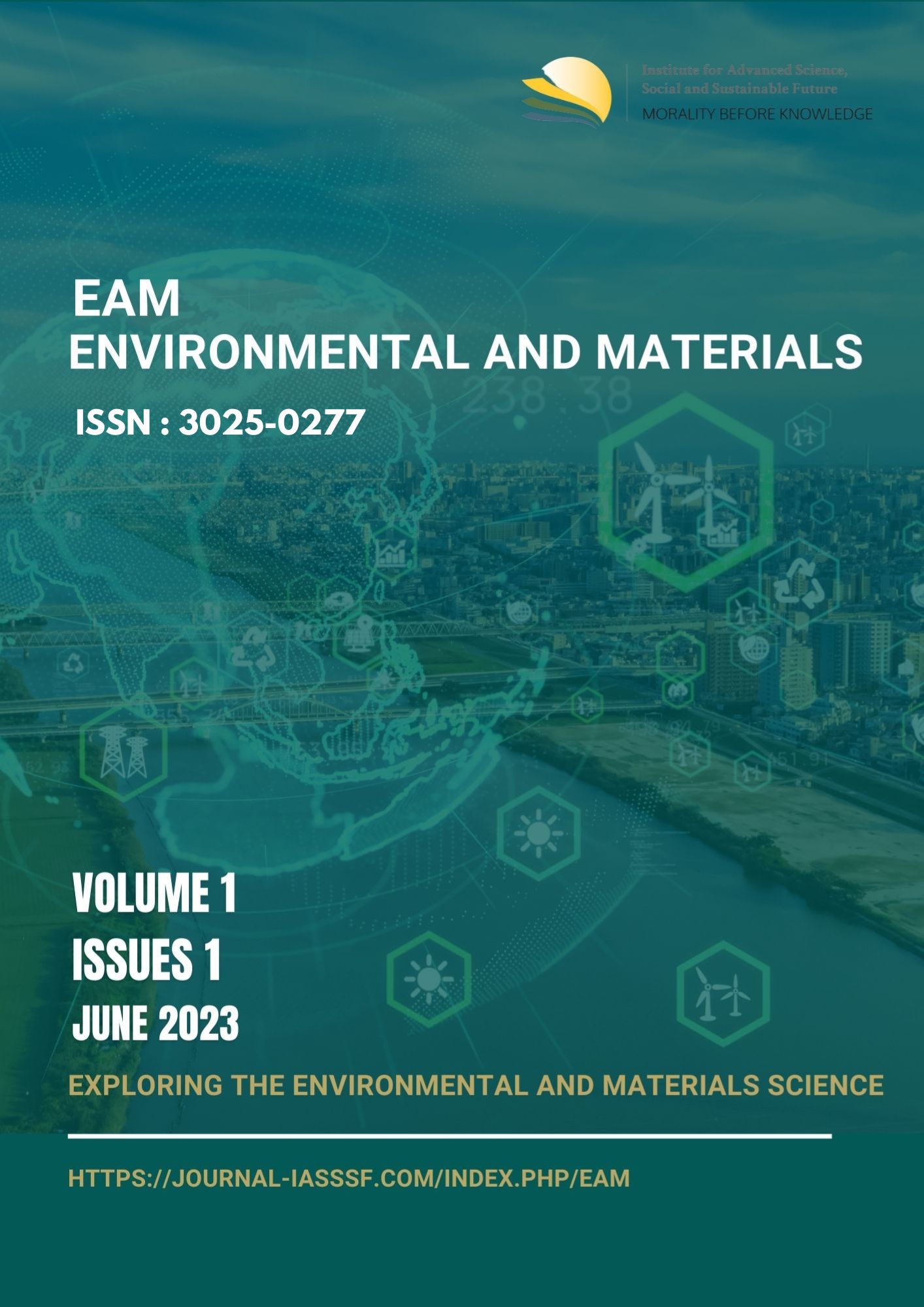Carbon-coated nickel foam for hypochlorous acid sensor
DOI:
https://doi.org/10.61511/eam.v1i1.2023.105Keywords:
carbon sphere-coated nickel foam, electrochemical sensor, HOCl, hydrothermal-carbonization method, non-enzymatic sensorAbstract
The electrochemical detection method of hypochlorous acid (HOCl) using carbon foam electrodes have been successfully developed. The carbon foam was prepared from carbon-coated nickel foam which is synthesized using a hydrothermal-carbonization method. SEM characterization indicated that the optimum synthesis of carbon-coated nickel foam has been achieved on the 4th layer coating process with an expected spherical structure, while characterization using FTIR and Raman spectroscopy confirmed the formation of graphitic material with D band and G band characteristics. An electroactive surface area of 0.0236 cm2 was achieved. Cyclic voltammetry of HOCl in 0.1 M phosphate buffer solution pH 6.0 showed the best current response for HOCl reduction occurs at a potential of -0.3 V (vs. Ag/AgCl). Further detection of HOCl using amperometry technique in the concentration range of 2-200 μg/mL showed good linearity with sensitivity of 9.112 mA/µg/L and an estimated detection limit of 1.96 µg/mL. Good repetition is indicated by the RSD value of 2.499 % (n=5). This developed sensor also showed good selectivity in the presence of interference compounds, such as FeCl2 and CuSO4. Besides, the determination of HOCl in tap water has been successfully conducted and generated a comparable result with the UV-VIS method (3.30 µg/mL hypochlorite). The results indicated that the developed sensor is promising for the detection of HOCl in environmental applications.
References
Andrés, C. M. C., Pérez de la Lastra, J. M., Juan, C. A., Plou, F. J., & Pérez-Lebeña, E. (2022). Hypochlorous Acid Chemistry in Mammalian Cells—Influence on Infection and Role in Various Pathologies. International Journal of Molecular Sciences, 23(18), 10735. https://doi.org/10.3390/IJMS231810735
Chaudhari, N. K., Jin, H., Kim, B., & Lee, K. (2017). Nanostructured materials on 3D nickel foam as electrocatalysts for water splitting. Nanoscale, 9(34), 12231–12247. https://doi.org/10.1039/C7NR04187J
dos Santos, M. C., Maynart, M. C., Aveiro, L. R., da Paz, E. C., & dos Santos Pinheiro, V. (2017). Carbon-Based Materials: Recent Advances, Challenges, and Perspectives. Reference Module in Materials Science and Materials Engineering. https://doi.org/10.1016/B978-0-12-803581-8.09262-6
Duan, X., Wang, X., Xie, Y., Yu, P., Zhuang, T., Zhang, Y., …. & Tao, Z. (2021). High concentrations of hypochlorous acid‐based disinfectant in the environment reduced the load of SARS‐CoV‐2 in nucleic acid amplification testing. Electrophoresis, 42(14–15), 1411-1418. https://doi.org/10.1002/ELPS.202000387
Duraisamy, V., Sudha, V., Dharuman, V., & Senthil Kumar, S. M. (2022). Highly Efficient Electrochemical Sensing of Acetaminophen by Cobalt Oxide-Embedded Nitrogen-Doped Hollow Carbon Spheres. ACS Biomaterials Science and Engineering. https://doi.org/10.1021/ACSBIOMATERIALS.2C01248/SUPPL_FILE/AB2C01248_SI_001
Gao, Y., Zhang, Y., Huang, H., Deng, C., & Cheng, Y. (2022). Low-Cost Carbon Derived from Coal-Coke for High-Performance Supercapacitors. SSRN Electronic Journal. https://doi.org/10.2139/SSRN.3994533
Hanigan, D., Truong, L., Simonich, M., Tanguay, R., & Westerhoff, P. (2017). Zebrafish embryo toxicity of 15 chlorinated, brominated, and iodinated disinfection by-products. Journal of Environmental Sciences, 58, 302–310. https://doi.org/10.1016/J.JES.2017.05.008
Hu, W., Zhao, M., Gu, K., Xie, L., Liu, M., & Lu, D. (2021). Fluorescent probe for the detection of hypochlorous acid in water samples and cell models. RSC Advances, 12(2), 777-784. https://doi.org/10.1039/D1RA08116K
Jia, J., & Ma, H. (2011). A water-soluble fluorescence resonance energy transfer probe for hypochlorous acid and its application to cell imaging. Chinese Science Bulletin, 56(31), 3266–3272. https://doi.org/10.1007/s11434-011-4645-2
Jović, M., Cortés-Salazar, F., Lesch, A., Amstutz, V., Bi, H., & Girault, H. H. (2015). Electrochemical detection of free chlorine at inkjet printed silver electrodes. Journal of Electro analytical Chemistry, 756, 171–178. https://doi.org/https://doi.org/10.1016/j.jelechem.2015.08.024
Kaur, J., Sharma, S., Mehta, S. K., & Kansal, S. K. (2020). Highly photoluminescent and pH sensitive nitrogen doped carbon dots (NCDs) as a fluorescent sensor for the efficient detection of Cr (VI) ions in aqueous media. Spectrochimica Acta. Part A, Molecular and Biomolecular Spectroscopy, 227, 117572. https://doi.org/10.1016/J.SAA.2019.117572
Kong, L., Lu, X., Bian, X., Zhang, W., & Wang, C. (2010). Accurately tuning the dispersity and size of palladium particles on carbon spheres and using carbon spheres/palladium composite as support for polyaniline in H2O2 electrochemical sensing. Langmuir, 26(8),5985–5990. https://doi.org/10.1021/LA904509V/ASSET/IMAGES/MEDIUM/LA-2009 04509V_0008.GIF
Kumar, D. R., Kesavan, S., Nguyen, T. T., Hwang, J., Lamiel, C., & Shim, J.-J. (2017). Polydopamine@electrochemically reduced graphene oxide-modified electrode for electrochemical detection of free-chlorine. Sensors and Actuators B: Chemical, 240, 818–828. https://doi.org/10.1016/j.snb.2016.09.025
Lam, E., & Luong, J. H. T. (2014). Carbon materials as catalyst supports and catalysts in the transformation of biomass to fuels and chemicals. ACS Catalysis, 4(10), 3393–3410. https://doi.org/10.1021/CS5008393/ASSET/IMAGES/MEDIUM/CS-2014008393_0001.GIF
Lau, A. T. Y., Wang, Y., & Chiu, J. F. (2008). Reactive oxygen species: Current knowledge and applications in cancer research and therapeutic. Journal of Cellular Biochemistry, 104(2), 657–667. https://doi.org/10.1002/JCB.21655
Martemucci, G., Costagliola, C., Mariano, M., D’andrea, L., Napolitano, P., & D’Alessandro, A. G. (2022). Free Radical Properties, Source and Targets, Antioxidant Consumption and Health. Oxygen 2(2), 48–78. https://doi.org/10.3390/OXYGEN2020006
Morais, R. G., Rey-Raap, N., Figueiredo, J. L., & Pereira, M. F. R. (2019). Glucose-derived carbon materials with tailored properties as electrocatalysts for the oxygen reduction reaction. Beilstein Journal of Nanotechnology, 10, 1089-1102. https://doi.org/10.3762/BJNANO.10.109
Murata, M., Ivandini, T. A., Shibata, M., Nomura, S., Fujishima, A., & Einaga, Y. (2008). Electrochemical detection of free chlorine at highly boron-doped diamond electrodes. Journal of Electroanalytical Chemistry, 612(1), 29–36. https://doi.org/10.1016/J.JELECHEM.2007.09.006
Nizer, W. S. da C., Inkovskiy, V., & Overhage, J. (2020). Surviving Reactive Chlorine Stress: Responses of Gram-Negative Bacteria to Hypochlorous Acid. Microorganisms 8(8), 1220. https://doi.org/10.3390/MICROORGANISMS8081220
Noor, T., Yaqoob, L., & Iqbal, N. (2021). Recent Advances in Electrocatalysis of Oxygen Evolution Reaction using Noble-Metal, Transition-Metal, and Carbon-Based Materials. ChemElectroChem, 8(3), 447–483. https://doi.org/10.1002/CELC.202001441
Nunes, E. W., Silva, M. K. L., Rascón, J., Leiva-Tafur, D., Lapa, R. M. L., & Cesarino, I. (2022). Acetylcholinesterase Biosensor Based on Functionalized Renewable Carbon Platform for Detection of Carbaryl in Food. Biosensors, 12(7), 486. https://doi.org/10.3390/BIOS12070486
Pathiratne, K., Skandaraja, S., & Jayasena, E. (2008). Linear sweep voltammetric determination of free chlorine in waters using graphite working electrodes. Journal of the National Science Foundation of Sri Lanka, 36(1), 25. https://jnsfsl.sljol.info/articles/10.4038/jnsfsr.v36i1.130
Rahmawati, I., Sanjaya, A.R., Putri, Y.M.T.A., Gunlazuardi, J., Tribidasari, I.A., (2023). An acetylcholinesterase-based biosensor for isoprocarb using a gold nanoparticles-polyaniline modified graphite pencil electrode. Analytical Sciences 2023, 1, 1–13. https://doi.org/10.1007/S44211-023-00296-7
Rahmawati, I., Saepudin, E., Fiorani, A., Einaga, Y. & Tribidasari, I.A. (2022). Electrogenerated chemiluminescence of luminol at a boron-doped diamond electrode for the detection of hypochlorite. Analyst, 147(12), 2696–2702. https://doi.org/10.1039/D2AN00540A
Ratsoma, M. S., Poho, B. L. O., Makgopa, K., Raju, K., Modibane, K. D., Jafta, C. J., & Oyedotun, K. O. (2023). Application of Nickel Foam in Electrochemical Systems: A Review. Journal of Electronic Materials, 52(4), 2264–2291. https://doi.org/10.1007/S11664-023-10244-W
Sanetuntikul, J., Hang, T., & Shanmugam, S. (2014). Hollow nitrogen-doped carbon spheres as efficient and durable electrocatalysts for oxygen reduction. Chemical Communications, 50(67), 9473–9476. https://doi.org/10.1039/C4CC03437F
Seymour, I., O’Sullivan, B., Lovera, P., Rohan, J. F., & O’Riordan, A. (2020). Electrochemical detection of free-chlorine in Water samples facilitated by in-situ pH control using interdigitated microelectrodes. Sensors and Actuators B: Chemical, 325, 128774. https://doi.org/10.1016/J.SNB.2020.128774
Silmi, N., Ivandini, T. A., & Asijati, E. W. (2018). Hypochlorous Acid Sensor using Boron-Doped Diamond Electrode in Physiological pH Solution. ISSIMM 2018 - 3rd International Seminar on Sensors, Instrumentation, Measurement and Metrology, Proceeding, 61–63. IEEE. https://doi.org/10.1109/ISSIMM.2018.8727635
Soto, N. O., Horstkotte, B., March, J. G., Alba, P. L. L. de, Martínez, L. L., & Martín, V. C. (2008). An environmental friendly method for the automatic determination of hypochlorite in commercial products using multisyringe flow injection analysis. Analytica Chimica Acta, 611(2), 182–186. https://doi.org/https://doi.org/10.1016/j.aca.2008.01.073
Sun, M., Yu, H., Zhu, H., Ma, F., Zhang, S., Huang, D., & Wang, S. (2014). Oxidative Cleavage-Based Near-Infrared Fluorescent Probe for Hypochlorous Acid Detection and Myeloperoxidase Activity Evaluation. Analytical Chemistry, 86(1), 671–677. https://doi.org/10.1021/ac403603r
Syukur, M.J., Rachmawati, I., Sanjaya, A.R., Ridwan, M., Fiorani. A., Einaga, Y., and Tribidasari I.A. (2023). Modification of Screen-printed Carbon Electrodes with Gold Particles to Enhance Luminol Electrochemiluminescence for Hydrogen Peroxide Detection, Sensors and Materials, 35(5), 1785-1799. https://sensors.myu-group.co.jp/sm_pdf/SM3288.pdf
Thiagarajan, S., Wu, Z.-Y., & Chen, S.-M. (2011). Amperometric determination of sodium hypochlorite at poly MnTAPP-nano Au film modified electrode. Journal of Electroanalytical Chemistry, 661(2), 322–328. https://doi.org/https://doi.org/10.1016/j.jelechem.2011.08.009
Ulfig, A., & Leichert, L. I. (2021). The effects of neutrophil-generated hypochlorous acid and other hypohalous acids on host and pathogens. Cellular and Molecular Life Sciences, 78(2), 385. https://doi.org/10.1007/S00018-020-03591-Y
Watanabe, T., Akai, K., & Einaga, Y. (2016). The reduction behavior of free chlorine at boron-doped diamond electrodes. Electrochemistry Communications, 70, 18–22. https://doi.org/10.1016/J.ELECOM.2016.06.010
Wonjung, L., Youn, H., Bae, J., & Kim, D. H. (2021). Solid-phase colorimetric sensor for hypochlorite. Analyst, 146(7), 2301–2306. https://doi.org/10.1039/D0AN02448A
Xu, W., & Gao, H. (2020). Preparation of bead-type NiOx(OH)y catalyst for hypochlorite conversion and reactive brilliant red K-2BP degradation. Journal of Environmental Chemical Engineering, 8(2), 103522. https://doi.org/10.1016/J.JECE.2019.103522
Zhai, C., Li, S., Wang, J., & Liu, Y. (2018). Nitrogen-doped porous carbon sphere supported Pt nanoparticles for methanol and ethanol electro-oxidation in alkaline media. RSC Advances, 8(63), 36353–36359. https://doi.org/10.1039/C8RA07848C
Zhai, Y., Dou, Y., Zhao, D., Fulvio, P. F., Mayes, R. T., & Dai, S. (2011). Carbon Materials for Chemical Capacitive Energy Storage. Advanced Materials, 23(42), 4828–4850. https://doi.org/10.1002/ADMA.201100984
Zhang, R., Song, B., & Yuan, J. (2018). Bioanalytical methods for hypochlorous acid detection: Recent advances and challenges. TrAC Trends in Analytical Chemistry, 99, 1–33. https://doi.org/10.1016/J.TRAC.2017.11.015
Zhang, W., Hao, L., Shang, L., Chai, D. F., Gao, Y., Li, J., Zhao, M., Liu, R., Zhang, Z., & Dong, G. (2022). Maize starch derived boron doped carbon spheres via facile solvothermal route as the photoluminescence sensor for determination of pH and Cr(VI). Nanotechnology, 33(27). https://doi.org/10.1088/1361-6528/AC61CB
Zhang, Z., Li, Y., Zhang, Z., Zheng, H., Liu, Y., Yan, Y., Li, C., Lu, H., Shi, Z., & Feng, S. (2022). An electrochemical modification strategy to fabricate NiFeCuPt polymetallic carbon matrices on nickel foam as stable electrocatalysts for water splitting. Chemical Science, 13(30), 8876–8884. https://doi.org/10.1039/D2SC02845J
Zuo, L., Zhou, T., Pannell, B. K., Ziegler, A. C., & Best, T. M. (2015). Biological and physiological role of reactive oxygen species – the good, the bad and the ugly. Acta Physiologica, 214(3), 329–348. https://doi.org/10.1111/apha.12515
















